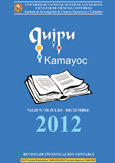Model for the knowledge management development in the research area
DOI:
https://doi.org/10.15381/quipu.v20i38.4526Keywords:
Conocimiento, capital intelectual, gestión del conocimiento, propiedad intelectual.Abstract
All organizations, whether they belong to the public or private sector, should have the necessary tools to meet the changing environment. The Knowledge Management, which is based on the measurement and evaluation of Intellectual Capital, provides the methodology for this purpose and is a management tool adaptable to any type of organization. However, it is difficult to apply this tool that has been designed for private companies, to the public institutions, especially in national universities. This paper seeks to present the way to apply of a theoretical model management to contribute to the development of scientific production in the Universidad Nacional Mayor de San Marcos, the model is based on Knowledge Management and was adapted to the characteristics of the institution public higher education. This article is the result of literature reviews and is part of the research project “Management model for development of application projects”
Downloads
Downloads
Published
Issue
Section
License
Copyright (c) 2012 Luisa Elena Salcedo Guzmán, Zelma Wong Torres

This work is licensed under a Creative Commons Attribution-NonCommercial-ShareAlike 4.0 International License.
AUTHORS RETAIN THEIR RIGHTS:
a. Authors retain their trade mark rights and patent, and also on any process or procedure described in the article.
b. Authors retain their right to share, copy, distribute, perform and publicly communicate their article (eg, to place their article in an institutional repository or publish it in a book), with an acknowledgment of its initial publication in Quipukamayoc .
c. Authors retain theirs right to make a subsequent publication of their work, to use the article or any part thereof (eg a compilation of his papers, lecture notes, thesis, or a book), always indicating the source of publication (the originator of the work, journal, volume, number and date).






